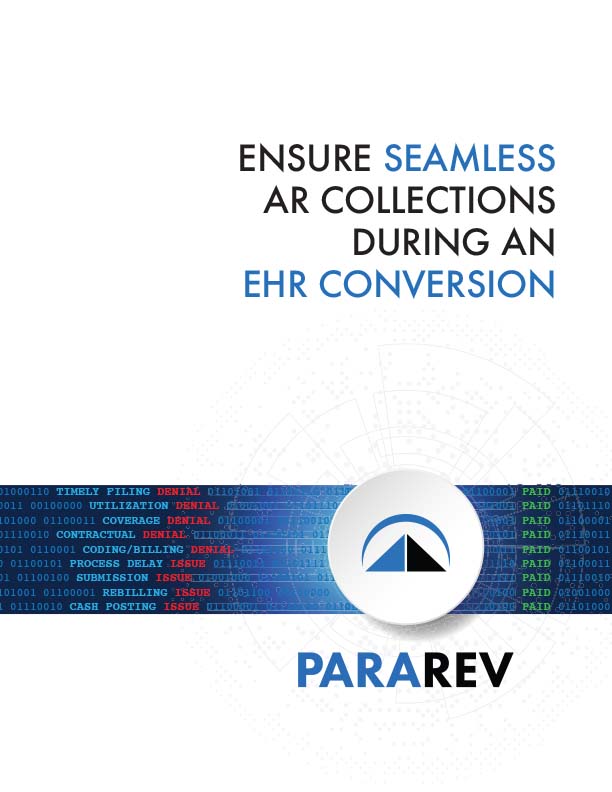How to Stop Leakage Along the Revenue Cycle Journey
An end-to-end reset of revenue cycle management (RCM) practices can help hospitals and health systems optimize collections and reduce denials as they work to overcome unrelenting margin pressure in today’s fast-changing operational environment.
What is revenue cycle management?
The revenue cycle is the financial engine that powers a healthcare organization. Complex, interlocking subsystems must mesh perfectly to ensure patient service revenues are consistently and accurately captured and collected. Shortcomings in any one of several key areas—clinical coding, claims submission and payment processing—can result in chronic underperformance and lost revenue.
How have hospitals been doing?
According to a report by Kaufman Hall, median hospital operating margins fell 71% from December 2021 to January 2022 to a minus-3.68%; operating room minutes fell by 16%, length-of-stay increased by 9%, and labor cost per adjusted discharge jumped by 15%.1
These impacts further undermined organizations that had already been struggling to improve cash flow and margins before 2020-2021. Facing rising costs and declining revenue, organizations are now starting to address fundamental but often-overlooked weaknesses in their traditional RCM practices. These problems can include:
- Mismatched or inappropriate pricing
- Registration inaccuracies and inefficiencies
- Porous charge capture
- Cumbersome pre-certification and case management
- Coding errors
- Ineffective claims editing
- Inadequate denial management and growing write-offs
- Deficient patient collections and limited or non-existent bad debt review
How can hospitals strengthen their RCM?
To stop revenue leakage, hospital must adopt a systematic approach that focuses on optimizing each phase of the revenue cycle. The following eight areas are critical to improved RCM performance:

1. Pricing Integrity
Facing new requirements to provide greater pricing transparency to consumers, hospitals have been pushing to develop and implement solutions that collect, organize and post enterprise pricing. But before this information can be shared publicly, healthcare organizations must be sure their prices make economic sense and are justifiable and competitive when compared to their peers. To accomplish this, providers need to create rational pricing models assembled around cost, reimbursement and peer pricing data.
The process starts with a review of existing pricing information across all hospital revenue streams, including emergency visits, room rates, diagnostic and therapeutic procedures, operating room, anesthesia, PACU, pharmacy and medical supplies. With this baseline established, comparisons can be made to a designated group of peer entities.
These comparisons allow hospitals to see exactly how their pricing stacks up against specific competitors and also against averages for the entire group. Quantifying the extent to which prices may deviate from group averages enables hospitals to quickly spot opportunities for increasing prices while still remaining competitive. Conversely, pricing models also enable the correction of higher prices that represent over-market outliers.
Equipped with solid pricing, hospitals now have the data required to comply with federal transparency rules. Making the hospital’s array of standard charges and prices for 300 specific shoppable healthcare services easily accessible online is a vital step toward improved patient engagement and satisfaction. It can also provide a competitive advantage, providing the numbers have been optimized before posting.

2. Pre-Registration
Providers are critically dependent on front-end registration staff for insurance coverage verification. Most registration personnel have access to real-time insurance eligibility software that uses the patient’s insurance number to confirm whether coverage is in place. But even though these systems are from 75-90% accurate, staff frequently fail to use the applications properly or even bother to use them at all. Reasons vary: They may not trust the system’s results; they may face productivity quotas and time pressure, or they may assume verification will be done later.
It’s true that the daily flow of patients can be relentless and registration personnel are frequently pushed to the limit. But that’s all the more reason for hospitals and physician offices to implement comprehensive processes that systematically flag coverage rejections and provide staff with an opportunity to resolve them, either before the patient arrives or before service is provided. They simply can’t afford not to: Unresolved claims due to insurance coverage issues can make up as much as one-quarter of all claim denials.2

3. Charge Capture
Charge capture involves accurately documenting medical services provided to patients so medical coders can attach the appropriate code to the service. Coders, as well as coding software, should be able to determine if the clinical documentation is complete. If it is not, an automated request system should be in place to quickly and accurately obtain the information required.
Incomplete or inaccurate documentation puts medical practices and hospitals at risk for both under-coding and over-coding. Under-coding results in money legitimately owned to the provider being left on the table. Over-coding can trigger expensive claw-backs, non-compliance penalties and even potential fraud charges.
Unfortunately, because codes continue to expand in number and also change frequently, under-coding and over-coding remain common problems. Capturing the correct information is therefore essential for correct claims processing. Having a system that can easily identify which staff members are consistently having documentation problems enables RCM managers to point these issues out and provide assistance to strengthen the charge capture process.

4. Pre-Certification and Case Management
Pre-certification is the review and approval process that payers, including commercial insurers, Medicare and Medicaid, mandate for some treatments and procedures. Beyond potentially disrupting or preventing required medical care, pre-authorizations can have a major impact on collections. An estimated 25% of claim denials result from utilization issues, which can include medical necessity, pre-authorization, DRG downgrades and experimental treatments.3
Mitigating utilization denials requires that hospitals be fully versed in payers’ clinical policy bulletins. These frequently changing documents describe what the payer will and won’t cover, how they define medical necessity and the treatments they consider to be experimental. Hospitals also must be ready to construct cogent and detailed appeal narratives that can make a strong medical case for the treatment provided.
Denials relating to authorizations can also be triggered by something as simple as a missing or misplaced authorization code. By reviewing claims information using intelligent automation capabilities, these kinds of mistakes can be quickly identified and addressed before submission.

5. Coding
Medical coding is how medical services are documented for billing purposes. Coding and billing mistakes are responsible for about 15% of all denied charges. One of the most common problems is the failure to implement automated solutions and edits that can provide safeguards against a range of coding errors. These capabilities can greatly reduce errors triggered by inappropriate CPT and HCPCS code usage, payment bundling and crosswalk mistakes, registration and demographic omissions or mistakes, as well as filing errors, including the failure to designate the patient responsibility portion of the claim.
Regular charge master reviews can identify invalid HCPCS/CPT® codes, help ensure line-item charge compliance and modifiers, confirm valid coding assignment, and match pricing alignment with fee schedules. These safeguards provide a critical baseline for coding accuracy and revenue cycle optimization.

6. Claim Submission
Claim submission entails the preparation and transmission of patient service claims to clearinghouses and on to payers for reimbursement. This phase of the revenue cycle represents providers’ final line of defense to ensure claim accuracy and resultant prompt payment. Critical to submission success are appropriate edits, or automated rules, that can flag deficient claims.
Failure to develop a robust and flexible editing system can create a domino effect of costly problems. These can include increasing denials and rising error rates, non-compliance penalties, and fraud and litigation expense.4 An estimated 9% of $3 trillion in hospital charges were initially denied in 2016, with the administrative cost of rework to overturn denials estimated at $118 per claim, or $8.6 billion nationwide.5
It is therefore important to incorporate into the revenue cycle automated, intelligent claims review edits that will quickly flag charge capture issues, coding and compliance errors, billing mistakes and documentation omissions or errors.

7. Insurance Follow-up and Root Cause Identification
Insurance follow-up (commercial, Medicare and Medicaid) includes any payer-provider communications or interactions aimed at resolving unpaid, delayed or denial claims. Root cause identification is part of a denial management process focused on working back from the denial to identify and rectify the underlying reason for the unpaid claim.
While some providers continue to task internal billing staff with working all denial follow-ups, others increasingly are opting for a hybrid approach that incorporates external resources and organizes claims by size and age. This strategy is particularly important in the face of growing shortages of qualified billing personnel. A recent survey of healthcare leaders found that 92% of respondents were facing challenges attracting and retaining support staff.6
A hybrid denial remediation approach typically incorporates three phases:
- Internal staff works commercial accounts up to 60 days from billing date
- A primary AR vendor works accounts for the next 120 days from day 60 to 180
- A pre write-off vendor, also known as a secondary AR management firm, focuses on highly aged claims of 180 billing days or greater
This triage strategy helps ensure all partial, late, or denied payments are systematically worked to resolution, regardless of size or age. As part of the process, rule-based denial mapping can be applied to identify how, why, and where denials are occurring. Typically, causes fall into one of seven categories: utilization, coverage, contractual, coding and billing, submission/ re-billing, cash posting and process delays. From detailed root-cause reports, providers can isolate and eliminate denial origins.

8. Patient Collections and Bad Debt/Zero Balance Review
One of the most effective ways to stabilize the revenue cycle is to develop comprehensive methods for improving patient collections before or at the time of service. A patient payment process should include providing accurate estimates through price transparency and multiple payment platforms. By taking lessons from the retail industry, providers can enhance the digital patient experience to maximize collections.
At the other end of the revenue cycle spectrum, specialized, forensic audits of written-off or zero balance claims provide an opportunity to ensure all available dollars are collected from payers. Zero-balance recoveries involve comparing payments received to anticipated revenue based on episode-of-care specifics, coding best-practices and payer-provider contractual terms. Any underpaid claims identified are resubmitted, per the payer’s terms, for reimbursement.
Recovered underpayments from zero-balance reviews can total 1% of write-off net placements, an amount that may be significant for large hospitals and health systems that typically write off tens of millions of dollars annually.
Developing a healthy revenue cycle
Now more than ever, providers can ill-afford to continue relying on outdated and inefficient RCM practices. Even though the pandemic is receding, organizations undoubtedly will face rising costs and downward pricing pressure in the years ahead. It is therefore critical that they assess and reengineer each phase of the revenue cycle to achieve incremental performance gains. Taken together, these improvements will accumulate to produce significant found revenue.
ParaRev can help
ParaRev, a leader in healthcare revenue cycle management, works side-by-side with you as a virtual extension of your hospital central billing office. We help you improve operating margins and collect more of your revenue through a seamless and collaborative partnership with your internal team.
Let ParaRev help your organization supplement any staffing shortages, stay on top of accounts receivable inventory, identify where and how to maximize revenue and, if not completed yet, implement a price transparency program.
Contact us today to learn how you can begin the process of transforming your revenue cycle.
- National Hospital Flash Report: February 2022, Kaufman Hall, Feb. 28, 2022.
- ParaRev internal data.
- Ibid
- Six Best Practices for Claims Editing, Optum Insight, 2012.
- Philip Betbeze, Claims Appeals Cost Hospitals Up to $8.6B Annually, HealthLeaders, June 26, 2017.
- Jacqueline LaPointe, Hospital Revenue Cycle Transformation Needed to Boost Performance, Rev Cycle Intelligence, Oct. 19, 2021.

Revenue Cycle Executive Game Plan: Proven Automation Strategies that Deliver Results
Download our free whitepaper to learn how a 6-step end-to-end action plan can transform your revenue cycle operations.










